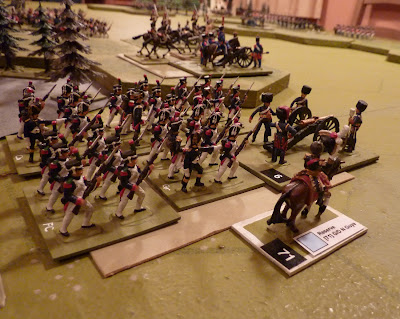Now that is a wargames room...
Just back from two very enjoyable days in North Wales, as a guest of John (he of 20mm Nostalgic Revival) and Cynthia, whom I must thank once again for their wonderful kindness and hospitality.
Apart from collecting an order of Les Higgins ECW figures, one big attraction for me was the opportunity to get some experience of ECW gaming. Accordingly, we played a full game on each of the two days. I'll pass quickly over the fact that I lost both games, mumbling feebly that at one stage I thought I was winning each battle. John has an unnervingly vigorous style of generalship, which includes a fondness for sacrificing his cavalry as quickly as possible! The first game looked a tad ambitious for introducing a rookie to the period - around 1000 castings, and a battlefield which was scenically pretty complex, but it worked out fine - we deliberately used simple rules. Charles F Wesencraft's Pike & Shot period rules from his Practical Wargaming (back in print - a recommended book for those who have missed it - Wesencraft was never as fashionable as some of his contemporaries). We deliberately did not use the later rules from CFW's With Pike & Musket, which had been improved rather in the direction of contemporary WRG practice. So the rules we used are functionally very simple - for example, missile fire - you are either in range or not. The game does not bother with niceties such as short range or anything like that. The only change we made was to halve all movement rates - they are very generous in the original. I thought this might mean we had to halve the missile ranges, too, but leaving them unaltered still gave the same sort of balance you will find in other mainstream ECW rules.
The battle lasted all day, but the overall story is quickly told. Both armies were successful early on their respective right flanks, and the Royalist infantry successfully held the line of a hedged road across the middle of the table, but gradually they were worn down, and brought up their reserves, who in turn were eventually driven back and off the field. End of battle - Parliamentary victory, but a very expensive one, I have to say!
My Royalist foot hold the road, before it all turned to rat-droppings
For the second day, we fought a rather smaller action, using the Victory without Quarter rules. Our implementation of the game was definitely on the rough-and-ready side, with a partial deck of playing cards for activation and cardboard chits to identify the units and commanders on the field. Apart from the fact that early successes were on the left flanks this time, the game played out surprisingly similarly to the previous one - even down to my losing...
VwQ is a good, fun game. Considering how short the rule "book" is, we took a little time to get the hang of what is quite a different style of game from what we (well, certainly I) have been used to. Once we got into it, however, it has it's own kind of logic and swing, it becomes a simple matter to carry in your head everything you need to know, and it went well. I am still intending to make it my ECW game of choice for the time being (well - once I have armies to fight with...) , but a couple of observations might be of interest here:
(1) From the generalship point of view, we should have allocated more brigadiers in our game. Units may be given an order when their card is drawn, but when a general officer's card is drawn, all of his units within a certain distance may be given orders, which is a big help. Outlying formations on a flank can become pretty well stranded if there is no brigadier with them - this point is duly noted for the future.
(2) If the armies start off some distance from each other, and have to march into contact, it would be useful to have some kind of bulk-order cards available for a few turns, to get things moving and keep the armies in decent shape - I'm thinking about this.
(3) The rules are not claimed to be complete, but we found a couple of things which we thought need to be covered more fully. Melees involving artillery are dealt with very sketchily - I think I would like to allow artillery to stand and fire if attacked, but to have zero capability if the enemy makes contact - that seems to accord with the spirit of the rules, but is less vague. Also, flank and rear attacks needed some extra rules - certainly for morale tests, and probably for fighting the actual melees also.
There is a great deal which works well, and gives a pleasingly sensible game. Given the possible need for a couple of tweaks, then, the rules passed the test pretty well. It would benefit from a properly prepared set of unit cards, though, and some nice-looking tokens to denote casualties, the need to reload and "shaken" would be good. We used laid-down single figures as casualty markers, and this gave rise to the hilarious sight of units charging around, dragging dead men along behind them. Given a proper level of preparation, then, this is a very enjoyable game - suitable for maybe a dozen-and-a-half units a side - and well worth checking out.
Thanks again, John!





























